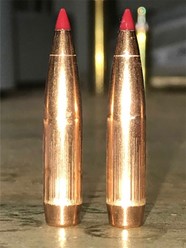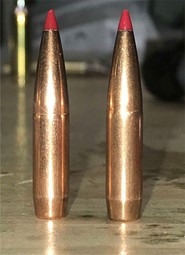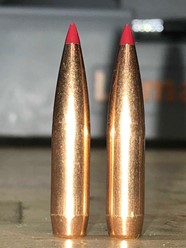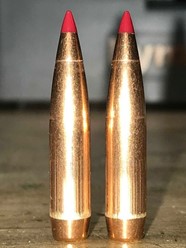Peterson Has New Coating
Chamfering the mouths of casings, prior to loading them with a bullet, has been a topic of debate in the reloading community since reloading became popular with private consumers. Does it make a difference in accuracy or consistency of bullet seating depth? Does it make a difference in how accurate your handloads perform? Does it prevent the bullet from having its’ jacket scarred up when it is inserted into the casing?
On the surface, it makes sense to chamfer the mouths of casings to prevent any burrs (which were produced from over-all-length trimming at the factory) from catching on the bullet jacket during loading. Since, on the surface, that theory seems to make sense, when we first started producing casings for hand loaders, we decided it was necessary to chamfer the inside of the casing mouths prior to packaging and shipping them to our customers.
Over the past couple years, we have debated internally here at Peterson Cartridge, whether or not chamfering the mouths of our casings actually prevents the projectiles being inserted into casings, from being scarred and gouged up. To get to the facts of the subject, we started performing different tests with our casings, and our competitor’s casings, to determine what actually prevents bullet jacket damage. The results we uncovered were quite surprising to us, and we thought our customers might like to know as well.
Below is a picture of two bullets which were inserted into Peterson 6.5 Creedmoor casings. The casings were not coated with any lubricants or anti-tarnish treatments. It is important to note that the two casings these bullets were inserted into had the inside of their mouths chamfered prior to the bullets being seated.
|

6.5mm Hornady 147 Grain ELD Match bullets inserted and extracted from uncoated Peterson 6.5 Creedmoor casings with inside neck chamfered.
|
As you can see from the above photo, even though the inside of the casing mouths were chamfered prior to loading the bullets, the bullet jackets were still scraped and scarred during the loading process. After seeing these results, we started to discuss whether the bullet jacket damage was a result of burrs on the inside of the mouth, or if it was from the surface finish / surface condition on the inside of the casing.
After about a year of trial and error experiments, we were able to locate a coating solution to the bullet-jacket-damage issue. After trying multiple potential coating solutions, we landed on one that had a lubricity component, while also helping to prevent corrosion / tarnish of our brass casings. Now that we found a coating that solved the bullet jacket damage issue, we needed to test the coating on our casings to ensure there were no unwanted side effects.
Over the course of a few months, we had our internal ballistician test Peterson casings, which had our new coating applied to them, for over a dozen potential issues that could arise from the new coating. Some of these tests included advanced aging testing, gumming testing, build-up testing, gun fouling testing, coating and powder interaction testing, and even a test where we loaded and fired 2,000 coated casings through the same gun, without cleaning it, to see if the coating would deposit onto the inside of the gun’s chamber and affect bullet velocity and/or consistency of feeding the rounds in or out of the chamber.
After all of these tests, which took hundreds of hours to complete, we were unable to find any areas where the new coating made the performance of our casings worse. The testing did, however, show us a multitude of ways the new coating positively affected our casings.
First and foremost, the new coating eliminated the bullet jacket damage issue. This claim is confirmed in the below picture.
|

6.5mm Hornady 147 Grain ELD Match bullets inserted and extracted from coated Peterson 6.5 Creedmoor casings without inside neck chamfer.
|
Besides solving the bullet jacket damage issue, as mentioned above, we observed other added benefits when we tested our casings with the new coating applied to them.
- More consistent bullet seating depth
- More consistent loaded cartridge over-all-length
- Reduced bullet seating force
- Reduced damage to bullet ogive during bullet seating
- Eliminates need to lubricate casings or projectiles if used in progressive press
- Easier cartridge feeding into chamber
- Easier cartridge ejection from chamber after firing
- Improved tarnish protection
- Eliminates need to manually chamfer casing mouths
- More consistent force required to release bullet from casing mouth during firing.
As a side experiment, we performed the same test described above on two of our better competitors. The 1st competitor is Norma. We don’t have any issue mentioning their name, as they performed really well in this test. Two bullets were inserted and removed from two of their 6.5 caliber casings, just as we did for ours during this test. The results are shown below.
|

6.5mm Hornady 147 Grain ELD Match bullets inserted and extracted from Norma 260 Rem casings directly from packaging.
|
As you can see from the above photo, the Norma casings we tested didn’t scar or scrape the bullet jackets when the projectiles were inserted and extracted from the casings. It is our belief that Norma also coats their casings with some type of lubricant / anti-tarnish at their factory prior to their packaging and shipping operations. Well done Norma!
As mentioned above, we performed the same experiment one last time on our other major competitor’s 6.5 caliber casings. They didn’t do as well in this test, so we will not use their name. As you can see from the below picture, even though the casings were slightly chamfered on the inside of the casing mouths, the bullet jackets were still scarred and gouged up when the bullets were inserted and extracted from the casings.
|

6.5mm Hornady 147 Grain ELD Match bullets inserted and extracted from other competitor’s 260 Rem casings directly from packaging.
|
The conclusion of this write-up on the testing we did, is that we have found another way to improve the product we sell our customers. It wasn’t easy, and it took a few hundred hours to complete the testing to ensure there were no unintended side effects from the new coating. However, we believe the added benefits our customers will receive from the new coating are worth the labor we put into this project.
When you receive casings from us with the new coating, you will likely not notice any difference in the appearance of the casings as the coating is colorless, odorless, invisible and imperceptible to the touch. It functions on a microscopic level to provide lubricity and anti-tarnish properties. The main differences you will notice are that bullets seem to seat more smoothly and with less force in, and that we no longer chamfer the mouths of our casings. If you have any questions regarding this new coating, or any other issue you have with our casings, please don’t hesitate to contact us at 724-940-7552 or bpreston@petersoncartridge.com.
About the author
Ben Preston
Ben Preston serves as Inspection and Shipping Manager at Peterson Cartridge. In this role, Ben is responsible for a stringent visual inspection process where he checks that every casing is free of defect. Ben oversees incoming and finished goods inventory and works to meet shipping deadlines.
Ben is an avid hunter and shooter with a passion and appreciation for high quality cartridges.




